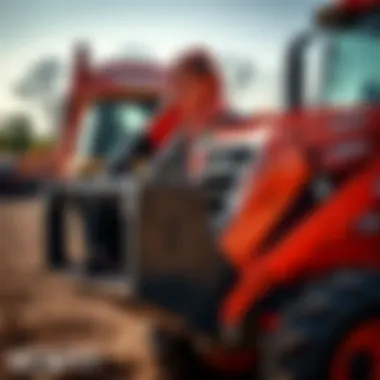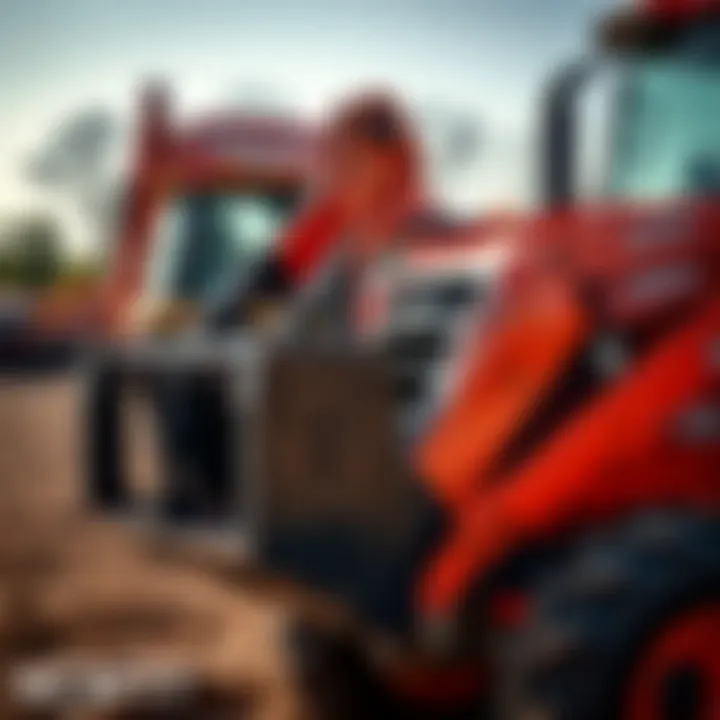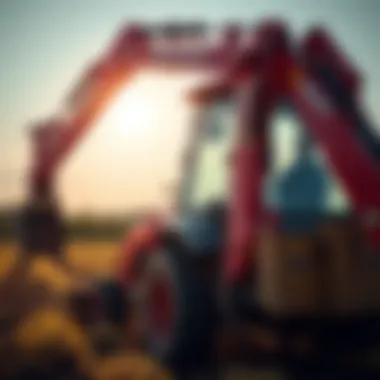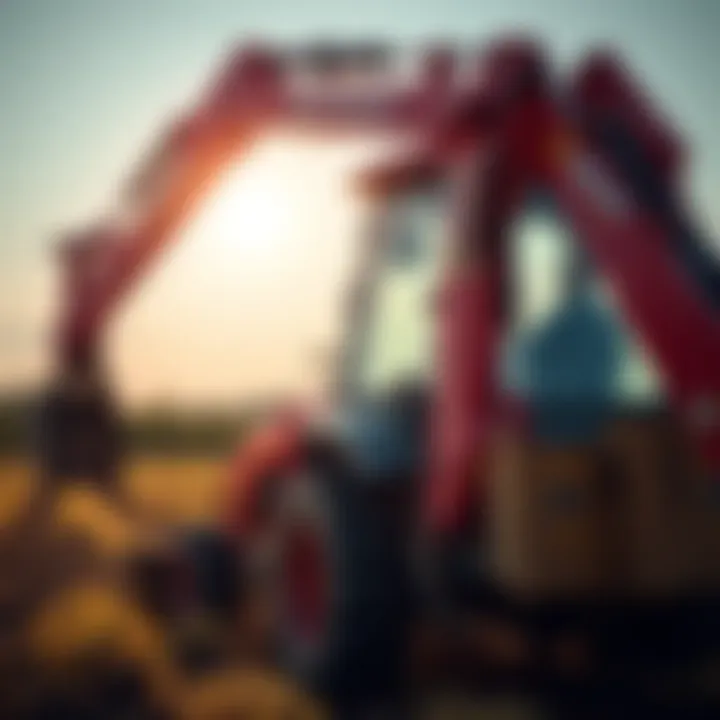Maximizing Efficiency with Sub Compact Tractor Backhoes


Intro
In today’s fast-paced agricultural landscape, sub compact tractors are gaining significant attention. These versatile machines are designed for a myriad of tasks, making them ideal for small farms, residential properties, and even larger agricultural operations. One attachment that stands out in terms of functionality is the backhoe. This powerful tool not only enhances the capabilities of the tractor but also brings efficiency and versatility to various farming tasks. As we embark on this exploration, we will discuss the main features, benefits, and considerations when using sub compact tractor backhoe attachments.
Latest Trends in Agriculture
Overview of Current Trends
The agriculture sector is in constant evolution, a pulse that beats to the rhythm of technology and innovation. One noticeable trend is the increasing adoption of smaller farming machinery. This pivot stems from the growing awareness that larger equipment often leads to excessive soil compaction and is not always necessary for tasks that can be efficiently performed by smaller units. Sub compact tractors are a prime answer to this demand, offering substantial power without the associated downsides of larger machinery.
Impact of Technology on Farming Practices
As with many industries, agriculture is slowly becoming intertwined with technology. The integration of advanced GPS systems, precision agriculture, and automation are reshaping traditional farming practices. Modern sub compact tractors are being outfitted with such technologies, making it easier for farmers to execute tasks with precision and less labor intensity. For instance, farmers can now utilize a backhoe attachment with updated controls that allow for smoother operations and increased productivity.
Harnessing the Power of Backhoe Attachments
Versatility in Operations
A sub compact tractor equipped with a backhoe opens up a whole new realm of possibilities. From digging trenches for irrigation to clearing small lands for planting, backhoes are well-suited for various tasks.
- Landscaping – Easily alter the terrain for aesthetics or function.
- Excavation – Digging postholes or foundations becomes significantly simpler.
- Maintenance – Tasks such as ditch cleaning and drainage can be handled with greater efficiency.
Compatibility with Different Tractor Models
Compatibility is a crucial point to consider when looking into backhoe attachments. Not every attachment fits every tractor. Farmers should extensively check the specifications and recommendations from manufacturers. Some well-known sub compact tractor brands include Kubota, John Deere, and Mahindra. Each offers a variety of models that accommodate different backhoe designs.
"Selecting the right backhoe for your tractor boosts productivity. Consult your dealer to ensure a proper fit and efficient operation."
Maintenance Tips for Optimal Performance
Owning a sub compact tractor backhoe attachment requires regular upkeep. Here are essential tips for ensuring longevity and optimal functionality:
- Regular Inspections – Conduct weekly checks of hydraulic systems, joints, and hoses for signs of wear or leaks.
- Cleaning – After each use, clear away debris and mud from both tractor and attachment to prevent corrosion.
- Lubrication – Apply lubricants to joints and moving parts as per the manufacturer’s guidelines.
Incorporating these practices can significantly extend the operational life of the backhoe and the tractor alike.
Sustainable Practices: Towards a Greener Future
Importance of Sustainability in Agriculture
When discussing modern farming, sustainability plays a pivotal role. Agricultural practices have a deep impact on the environment, and utilizing efficient tools like sub compact tractor backhoe attachments can help mitigate adverse effects. By optimizing land use and reducing the energy expenditure associated with larger equipment, farmers can promote a healthier ecosystem.
Methods for Sustainable Farming
Practices such as cover cropping and reduced tillage can be complemented with the use of sub compact tractors and backhoe attachments. These practices protect soil quality and improve crop yield while minimizing fossil fuel consumption. Adding backhoe capabilities to a sub compact tractor means less need for outside services, ultimately promoting self-sufficiency in farming operations.
Gardening Techniques and Tips
Essential Gardening Tools and Equipment
For hobbyist gardeners, small tractors equipped with backhoe attachments can simplify the challenges of garden preparation. By utilizing the right tools, tasks like tilling and planting can be executed efficiently. Tools critical for sub compact tractors, along with a backhoe, include:
- Rake for leveling soil
- Tiller for soil aeration
- Plow for efficient soil turning
Seasonal Gardening Practices
Each season requires specific practices to ensure a fruitful harvest. Investing in a backhoe attachment can help prepare gardens by:
- Spring: Digging and preparing planting beds.
- Summer: Clearing weeds and maintaining pathways.
- Fall: Tilling soil for next year’s crops.
Prelude to Sub Compact Tractors
In today’s fast-paced agricultural landscape, sub compact tractors stand out for their unique blend of flexibility and efficiency. Understanding these machines is crucial, especially for farmers and enthusiasts looking to optimize their operations. What sets sub compact tractors apart is not just their size but their ability to perform a multitude of tasks, making them indispensable on farms and properties of various scales.


Definition and Purpose
Sub compact tractors are typically smaller and lighter than their standard counterparts, designed to maneuver around tight spaces without compromising on power. This diminutive stature allows them to operate effectively in urban farms, smaller agricultural plots, and residential properties alike. Essentially, these tractors offer a balance of power and precision. Their primary purpose is to assist with diverse farming tasks—everything from tilling soil to lifting heavy loads with assorted attachments, such as backhoes.
The versatility of sub compact tractors enables users to tackle a variety of jobs efficiently, thus saving time and resources. For instance, when paired with a backhoe attachment, these tractors allow for easy excavation and landscaping.
Components of Sub Compact Tractors
Understanding the main components of sub compact tractors is vital for anyone considering their use.
- Engine: These tractors usually come equipped with fuel-efficient engines that provide sufficient horsepower for various tasks without guzzling fuel.
- Transmissions: Many sub compact tractors are equipped with hydrostatic transmissions that allow for seamless operator control, contributing to ease of use.
- Attachments: Designed to support a wide array of implements, including backhoe attachments, loaders, and mowers, making them incredibly versatile.
Each of these components plays a significant role in enhancing the tractor's performance and safety, ensuring that it can adapt to the demands of different tasks.
Comparison with Standard Tractors
When comparing sub compact tractors to standard models, several important distinctions arise.
- Size and Weight: Sub compact tractors are notably smaller, which makes them easier to transport and maneuver in confined areas. Standard tractors, while powerful, often require larger turning radiuses and can be cumbersome in tight spots.
- Power vs Efficiency: Standard tractors may offer higher horsepower, but sub compact models excel in efficiency for smaller-scale tasks, allowing users to conserve fuel and reduce operational costs.
- Versatility: While standard tractors are often tailored for specific large-scale agricultural tasks, sub compact tractors shine in their multifaceted roles. They can handle landscaping, digging, and even hauling, proving indispensable for small farms or residential properties.
In summary: Sub compact tractors offer a unique value proposition, being small yet mighty. Their diverse applications make them suited for a range of agricultural tasks, particularly when employing attachments like backhoes that amplify capabilities.
The information presented thus far provides a solid footing for understanding the role of sub compact tractors within modern agriculture. As we dive deeper into specific attachments like backhoe implements, it becomes crucial to recognize the foundational aspects of these versatile machines.
Understanding Backhoe Attachments
Backhoe attachments are crucial components for any sub compact tractor owner looking to maximize their capacity to perform various tasks efficiently. These attachments transform otherwise standard machinery into versatile tools capable of handling an array of functions, from digging to lifting. Understanding how backhoe attachments work and their suitability to different tasks is vital for both effectiveness and safety in agricultural operation.
Functionality of Backhoe Attachments
The functionality of backhoe attachments hinges on their ability to perform multiple operations efficiently. Primarily, they enable operators to excavate soil, remove debris, and perform trenching—all tasks commonly required in farming and landscaping.
Backhoe attachments are equipped with a hydraulic boom, arm, and bucket. The hydraulics allow for precise control and power, giving operators the finesse to manage delicate tasks such as digging around utilities or large-scale jobs like trenching for irrigation systems. The flexibility in the adjusting angles and depth of the bucket adds to their usability, making them a critical addition to any farming toolkit.
One cannot overlook the importance of safety protocols when operating backhoe attachments. Operators must be trained to understand the load limits and the dynamics of the equipment. Misjudgment in these aspects could lead to equipment damage or, worse, personal injury. Proper operator training and adherence to safety measures ensure that tasks are completed effectively while minimizing risks.
"The benefits of utilizing a backhoe attachment cannot be overstated; operational efficiency coupled with enhanced safety protocols makes them indispensable on the field."
Types of Backhoe Attachments
When venturing into the world of backhoe attachments, it’s paramount to recognize the various types available, each tailored to accomplish specific tasks. Knowing these types can help operators choose the right attachment for their tractor, thereby maximizing productivity.
- Standard Digging Buckets: These are your workhorses, making them essential for general digging tasks. They can range in size from small to large and are designed to handle most excavation jobs.
- Grading Buckets: Primarily used for leveling and grading soil. Their shape allows for better maneuverability, making them perfect for landscape projects where precision is key.
- Severe-Duty Buckets: Built for tough conditions, these buckets can handle rocky terrains and heavy-duty tasks without giving way. Ideal for farmers who deal with rough land conditions.
- Backhoe Rippers: These attachments are specialized for breaking up tough ground. They're particularly useful for land clearing projects where the soil is compacted.
- Hydraulic Breakers: If your tasks require breaking rock or concrete, a hydraulic breaker attachment is your best bet. It adds a whole new layer of capability to a sub compact tractor.
Using the right type of backhoe attachment ensures that tasks are completed efficiently and effectively, enhancing overall productivity in any agricultural project. Always consider the specific needs of the job at hand when selecting an attachment to maximize its benefits.
Advantages of Using Backhoe Attachments
Sub compact tractor backhoe attachments have increasingly found their place within the farming community, bridging the gap between efficiency and effective operation. The importance of understanding the advantages of these attachments cannot be overstated, especially given today’s fast-paced agricultural environment where every minute counts, and every dollar matters.
These backhoe attachments are not merely tools; they represent a significant leap forward in performing essential tasks such as digging, lifting, and moving materials. They transform sub compact tractors from simple yard equipment into versatile machines capable of tackling a variety of challenges. This section delves into the specific benefits, highlighting how they enhance productivity, contribute to cost savings, and offer remarkable versatility in application.
Increased Efficiency in Tasks
When it comes to performing tasks on the farm, time is of the essence. Sub compact tractor backhoe attachments bring much-needed efficiency to various operations. For instance, digging holes for fence posts or planting trees can be notoriously time-consuming when done by hand or with basic tools. However, equipping your tractor with a backhoe allows you to tackle these jobs in a fraction of the time.
This efficiency translates to more than just speed. With a backhoe attachment, the accuracy of digging and soil handling also improves, reducing the risk of damaging surrounding areas. In effect, farmers can focus on other important tasks while maintaining high productivity. It's like having a dependable sidekick that does the heavy lifting—literally. Some tasks that benefit significantly include:
- Digging trenches for irrigation systems.
- Excavating soil for planting.
- Removing stumps or boulders from fields.
Cost-Effectiveness
The farm budget often dictates the equipment decisions. Investing in sub compact tractor backhoe attachments can lead to substantial savings over time. These attachments help reduce labor costs, which can be a considerable expense in farming operations. Not only do they cut down on labor hours, but they also minimize the need to hire specialized contractors for tasks that require heavy machinery.
Additionally, these attachments are typically more affordable than acquiring a standalone backhoe loader. By opting for an attachment instead of an entirely separate machine, farmers can save on both purchase price and maintenance costs. Broken down:


- Reduced labor expenses due to faster operations.
- Lower upfront investment, making it accessible for smaller farms.
- Fewer repair and maintenance costs, as they can work on the existing tractor.
Versatility in Application
One of the standout features of sub compact tractor backhoe attachments is their versatility. This ain't just about digging; it’s about doing a multitude of tasks that make them invaluable on the farm. For example, these attachments can be utilized for:
- Landscaping projects, whether it’s leveling ground or shaping pathways.
- Installation of utility lines, allowing easy access to both residential and agricultural areas.
- Construction projects, where quick excavation is essential.
The flexibility of these attachments means that farmers don’t just limit themselves to one type of job. They can easily switch between tasks without needing to acquire different equipment, maximizing their investment.
"Flexibility and efficiency make the sub compact backhoe attachment truly remarkable in modern agriculture."
Compatibility Considerations
When considering the integration of a backhoe attachment to a sub-compact tractor, understanding compatibility is essential. This section delves into a few critical aspects: tractor specifications, attachment versatility, and hydraulic requirements. Each element is interlinked to ensure that farmers and enthusiasts maximize the utility of their equipment while minimizing operational hassles.
Tractor Specifications
Not all sub-compact tractors are created equal. Different models, such as the Kubota BX series or the John Deere 1025R, have distinct specifications that dictate their compatibility with backhoe attachments. Tractor specifications cover several factors, including size, weight distribution, and horsepower. A tractor with inadequate horsepower may struggle to efficiently operate a heavy backhoe attachment, leading to inefficiencies and potential damage. Moreover, the wheelbase and overall dimensions play a vital role in stability when the backhoe is in use. It’s wise to consult manufacturer guides to verify compatibility before purchasing any attachment.
- Key considerations for tractor specifications include:
- Horsepower: Ensures the tractor can handle the attachment's demands.
- Weight: Adequate weight ensures stability during operation.
- Wheelbase: Provides a balanced operation, reducing the risk of tipping.
Attachment Versatility
The versatility of backhoe attachments is another vital factor in ensuring compatibility. Not every attachment suits every tractor, and variants in design may offer distinct advantages or limitations. Some attachments are designed for specific tasks, while others might be multi-functional. The ability to interchange attachments can save both time and costs. For instance, some farmers might find a single attachment necessary for managing landscaping projects while simultaneously performing tasks like digging or trenching. Furthermore, manufacturers often offer guidelines or specific models suited for particular tractors, making it easier for users to select the right equipment.
- Versatility can be digestible in terms of:
- Task suitability: Make sure the attachment matches your needs.
- Ease of switching: Some attachments are easier to mount and dismount than others.
Hydraulic Requirements
Hydraulic requirements are the backbone of how effectively a backhoe functions. A properly matched hydraulic system between the tractor and attachment is crucial. Different backhoe attachments operate at specific pressure and flow rates, influencing their performance. For example, a backhoe requiring a flow rate of 10 GPM (Gallons Per Minute) will need to be used with a tractor that can supply that flow without creating unnecessary wear on the system. Additionally, understanding whether the tractor's hydraulic connections are compatible or if adapters are necessary helps maintain seamless operation.
Efficient hydraulic systems lead to smoother operations and less downtime.
- Hydraulic considerations to keep in mind include:
- Flow rate: Has to match the attachment.
- Pressure specifications: Ensure the hydraulic system can handle the demands.
- Connection type: Check if adapters are needed for fittings.
Operational Guidelines
Operational guidelines play a crucial role when it comes to using sub compact tractor backhoe attachments. Understanding how to use these attachments effectively can be the difference between accomplishing tasks efficiently and encountering setbacks. Proper guidance ensures safe operations and prolongs the life of both the attachment and the tractor itself.
Safety Protocols
Prioritizing safety is non-negotiable in any work environment, and this holds especially true when using a sub compact tractor backhoe attachment. Adhering to safety protocols helps mitigate risks that could lead to injury or equipment damage. Here are some essential safety measures:
- Personal Protective Equipment (PPE): Always wear appropriate PPE, including helmets, gloves, and safety glasses, to minimize risks of injury.
- Site Assessment: Before starting operations, inspect the job site for hazards such as overhead power lines and unstable ground.
- Clear Communication: Establishing clear signals with team members can avoid misunderstandings that lead to accidents.
- Check Equipment: Always ensure that the backhoe attachment is properly attached to the tractor, without any loose bolts or damaged parts.
"Safety is not just a priority; it’s a commitment to protecting lives and livelihoods."
Daily Maintenance Checks
Routine maintenance checks are essential for ensuring the tractor backhoe attachment operates smoothly. Neglecting maintenance can lead to malfunctioning equipment, which in turn can hinder productivity. Here are steps to perform daily maintenance checks:
- Fluid Levels: Regularly check hydraulic fluid and engine oil levels to prevent overheating and ensure efficient operation.
- Tightness of Components: Inspect bolts, hoses, and all connections for tightness to avoid losing hydraulic pressure during operation.
- Inspect Wear Parts: Carefully examine the teeth of the backhoe bucket and other wear parts for degradation and replace them as necessary.
- Clean After Use: Clean the attachment and tractor after use to remove dirt and debris, which can lead to corrosion or further wear.
Integrating these operational guidelines sets a strong foundation for using sub compact tractor backhoe attachments effectively and safely in agricultural practices. This, in turn, enhances overall productivity and ensures the longevity of the equipment, making the investment worthwhile for farmers and enthusiasts alike.
Best Practices for Effective Use
Understanding how to effectively use backhoe attachments can be the difference between a seamless operation and a frustrating experience. When it comes to sub compact tractor backhoe attachments, employing best practices ensures not only safety but also optimized performance in agricultural work. These practices provide guidance comes from both experience and technical know-how, aiming at enhancing productivity while minimizing risks. Clearly, having a reliable approach to operating these tools is necessary for maximizing their benefits.


Technique Mastery
Mastering the operational techniques of backhoe attachments takes time and practice. It isn't just about jumping in the seat and going to town; there's more to it. Knowledge of controls, machine balance, and maneuvering come into play here. Familiarity with the equipment's controls allows an operator to be more responsive and precise—important traits when navigating rough terrains or tight spots.
- Practice Safe Operation: Always start with an understanding of the attachment and tractor capabilities. Know the limits of your machine. There’s no point in taking unnecessary risks that might lead to breakdowns or accidents.
- Learn the Geometry: Understand how the backhoe arm moves in relation to the tractor. The arm's range may be limited based on the soil conditions or the design of the tractor. Knowing this helps in positioning it better for various tasks.
- Fluid Coordination: Spending time honing hand-eye coordination can be beneficial. The more familiar you are with the controls, the more confidently you'll be able to handle the attachment, especially in complex situations—like digging near structures or planting without damaging utility lines.
“Practice does not make perfect. Only perfect practice makes perfect.” – Vince Lombardi
This quote rings true when looking at backhoe operation. Rehearsing incorrect techniques will only lead one to repeat those mistakes. Thus, it’s better to engage in targeted practice with supervision whenever possible, gaining insights that can facilitate technique refinement.
Load Handling and Stability
Once the basic techniques are mastered, the next hurdle is understanding how to handle loads effectively and maintain stability. Mismanagement during load handling can lead to tipping, accidents, or worse, damaging both equipment and yourself.
- Weight Distribution is Key: When loading the backhoe with materials, always consider the weight distribution. Unequal loads can throw the machine off balance, leading to stability issues. Ensure you’re loading in a way that promotes stability by keeping heavier items near the base of the attachment.
- Lowering and Lifting Techniques: When moving loads, lower the arm close to the ground to maintain the tractor’s center of gravity. This way, you minimize the chance of toppling over. Likewise, always lift with control, avoiding jerky movements.
- Use Proper Attachments: Ensure that the bucket or tool at the end of the arm is suitable for the job. Using a bucket that is too large can lead to unmanageable loads—stick to what the equipment is designed for.
As with many agricultural practices, effective load handling is not just about physical strength; it's also about an understanding of physics and equipment dynamics. Each task should be approached strategically, considering both the load and the terrain.
By integrating these practice-oriented strategies into your routine, you're prepared to extract the most value from your sub compact tractor backhoe attachment. Mastering these elements lays the groundwork for better productivity and a safer work environment.
Market Trends and Innovations
Market trends and innovations in sub compact tractor backhoe attachments are not merely noteworthy; they represent the dynamic nature of agricultural machinery. The continually shifting landscape highlights the necessity for farmers and agribusinesses to stay abreast of evolving tools and techniques. This section dissects significant innovations while considering their implications for both efficiency and enhancement of productivity.
Emerging Technologies in Attachments
With the rapid advancement of technology, the very design and functionality of backhoe attachments have undergone a metamorphosis. One notable trend is the integration of precision technology. Systems such as GPS and automated controls are making their way into these attachments, allowing for exceptionally precise digging and placement. Such advancements can minimize waste and increase the accuracy of tasks, significantly aiding farmers in achieving their desired outcomes.
Automation is another game-changer, transforming how backhoe attachments function. Imagine a scenario where your attachment can adjust its parameters based on the soil's resistance or terrain. These features can lead to considerable savings on time and labor costs, freeing up resources for other essential farming operations.
Furthermore, hydraulic technologies are evolving to provide greater power and efficiency. More robust hydraulics mean backhoes can handle heavier loads with less effort, enhancing both performance and longevity. Farmers can accomplish more in less time, which translates to improved productivity on the ground.
- Key Features of Emerging Technologies:
- Integration of GPS systems
- Automation for dynamic adjustments
- Enhanced hydraulic systems for improved power
Sustainability Considerations
The agriculture sector is increasingly under pressure to adopt sustainable practices, and sub compact tractor backhoe attachments are no exception. Farmers are looking for not only efficient solutions but also environmentally sound ones. This has spurred manufacturers to focus on developing attachments that consume less fuel and emit fewer pollutants.
One pivotal aspect of sustainability in this context is the use of durable materials. Manufacturers are investing in robust yet lightweight materials that extend the life of attachments while reducing their environmental footprint. For instance, using aluminum and advanced composites makes attachments lighter, minimizing the machinery's overall weight and energy consumption during operations.
Another significant consideration revolves around energy efficiency. Recent designs aim to optimize hydraulic systems, which allows for less energy drain. As energy costs rise, having equipment that operates more efficiently directly affects a farmer's bottom line, leading to cost savings that can be reinvested into the enterprise.
- Sustainable Practices in Attachment Design:
- Use of durable materials that reduce waste
- Optimized hydraulic systems for better energy usage
- Features that lower emissions during operation
"Innovations not only improve efficiency; they also align with the growing necessity for sustainable practices across the agricultural spectrum."
As we celebrate progress in sub compact tractor backhoe attachments, it’s clear that the market trends and innovations are pivotal to shaping the future of farming. Staying in tune with these developments will equip farmers to harness the full potential of their equipment, ensuring they remain competitive in an ever-changing agricultural landscape.
The End
As we wrap up our exploration of sub compact tractor backhoe attachments, it becomes clear just how pivotal these tools are in agricultural settings. When considering operations that demand efficiency and versatility, backhoe attachments emerge as indispensable assets for anyone involved in farming. They streamline tasks that traditionally required multiple machines, minimizing time and labor costs.
Summarizing Key Points
The narrative surrounding sub compact tractor backhoe attachments reveals several key takeaways:
- Functionality: These attachments are engineered to enhance the operational capacity of sub compact tractors, allowing for tasks ranging from digging to lifting heavy loads.
- Cost Efficiency: With the rising costs of farming equipment, utilizing a backhoe attachment can significantly cut down on expenditures related to separate machinery.
- Versatility: The multifunctional nature of backhoe attachments means they can be utilized in various applications, be it landscaping, excavation, or even farm maintenance.
- Compatibility Considerations: Understanding the specifications and hydraulic requirements of both the tractor and attachment ensures optimal performance without damaging crucial components.
- Operational Efficiency: Streamlined work processes can be achieved with better training and maintenance of these attachments, enhancing productivity on the farm.
In essence, these points highlight not only the utility of backhoe attachments but also their role in modernizing agricultural practices and improving overall farm management.
Future Directions for Use
Looking ahead, the trajectory of sub compact tractor backhoe attachments is promising. With the agriculture sector continuously evolving, here are some insights into what might come next:
- Innovative Technologies: Advances in technology may lead to smart backhoe attachments that integrate GPS and automated systems for greater precision in tasks.
- Sustainability: As environmental concerns take center stage, future designs may focus on eco-friendly materials and operations, reducing the carbon footprint of agricultural equipment.
- Enhanced Training Programs: Continuous education on best practices and safety protocols could emerge, ensuring users are well-equipped to handle these attachments efficiently and safely.
- On-Demand Service Platforms: The rise of digital platforms could lead to easier access to service, parts, and expert knowledge for farmers using sub compact tractor backhoe attachments.
As agriculture continues to adapt and grow, the future of backhoe attachments will likely align with broader trends in the industry, driving efficiency and productivity to new heights. A commitment to innovation will play a critical role in supporting agriculture’s quest for sustainability and effectiveness.







